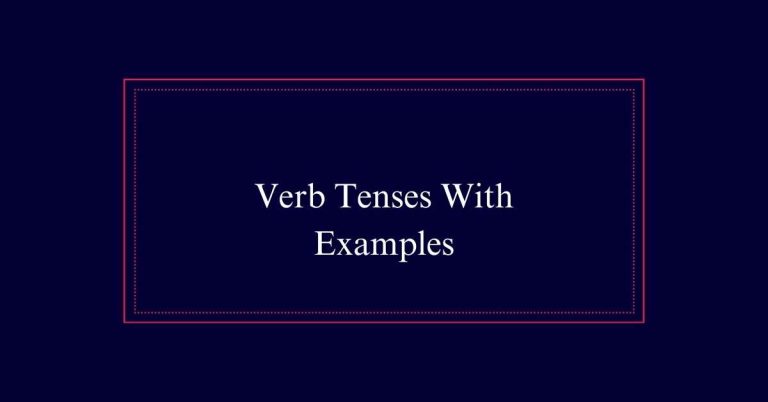How to Write Negative Verbs Correctly?
To write negative verbs correctly, use the formula: auxiliary verb + not or a negative contraction + main verb. For the verb “to be,” place “not” immediately after it, ensuring subject-verb agreement and tense consistency. Avoid double negatives to maintain clarity. In American English, use “do not” or “don’t,” while British English often prefers “have not” or “haven’t.”
Negative Verb Structure
Understanding the structure of negative verbs is essential for clear communication.
To form a negative verb, use the formula: auxiliary verb + not or negative contraction + main verb. For example, ‘She does not understand’ or ‘She doesn’t understand.’
The verb ‘to be’ is an exception, negated as ‘to be + not,’ such as ‘He is not here.’ British English often treats the verb ‘to have’ differently than American English.
Correct placement of ‘not’ is vital. Incorrect placement can alter meaning, like in ‘He attends not his classes regularly.’
Negating With ‘To Be’
Negating the verb ‘to be’ follows a distinct rule where ‘not’ is placed directly after the form of ‘to be.’ This structure is straightforward and guarantees clarity.
For instance, ‘She is not happy’ and ‘They are not coming’ follow this pattern. The negation can also be contracted for a more informal tone, such as ‘She isn’t happy’ and ‘They aren’t coming.
Here are key points to remember:
- Place ‘not’ immediately after ‘to be.’
- Contractions are common in spoken English.
- Maintain clear subject-verb agreement.
- Avoid double negatives, e.g., ‘isn’t not.’
- Ensure the tense is consistent.

British English Exceptions
In British English, the verb ‘to have’ often follows different negation rules compared to American English. In British English, it is common to use ‘have not’ or ‘haven’t’ rather than ‘do not have’ or ‘don’t have.’ This distinction is important for clarity and correctness in writing.
| British English | American English | Example Sentence |
|---|---|---|
| I haven’t a clue. | I don’t have a clue. | She hasn’t a car. |
| She hasn’t a car. | She doesn’t have a car. | I haven’t any money. |
| We haven’t any time. | We don’t have any time. | We haven’t any time left. |
American English Rules
American English typically negates the verb ‘to have’ using ‘do not have’ or its contraction ‘don’t have.’ This differs from British English, which often uses ‘haven’t’ or ‘have not.’ Understanding these differences is essential for clear communication in American English.
Here are key points to remember:
- Use ‘do not have’ or ‘don’t have’ for negation.
- Avoid using ‘haven’t’ in American English.
Guarantee subject-verb agreement in negative sentences.
Maintain clarity by sticking to standard negation forms.
Practice to become familiar with regional differences.
Correct Adverb Placement
Understanding regional differences is important, but ensuring correct adverb placement in negative sentences is equally essential for clarity. Proper adverb placement prevents confusion and maintains the intended meaning.
For example, ‘Pablo does not attend his classes regularly’ is clear and precise. Placing the adverb ‘not’ correctly after the auxiliary verb ‘does’ ensures the sentence is understood as intended. Incorrect placement, such as ‘Pablo attends not his classes regularly,’ can lead to misunderstandings.
Adverbs should be placed immediately before the main verb or after the auxiliary verb in negative sentences. This standard maintains consistency and improves readability.
Common Errors to Avoid
One major error in forming negative verbs is the incorrect placement of adverbs. This mistake can change the meaning of a sentence, leading to confusion.
Writers often struggle with maintaining the correct word order in negative sentences. In addition, unfamiliarity with regional differences in English can cause errors.
To avoid these pitfalls, keep the following points in mind:
- Always place ‘not’ after the auxiliary or modal verb.
- Avoid using double negatives, such as ‘don’t never.’
- Make sure the verb ‘to be’ follows the structure: to be + not.
- Understand the difference in negation rules between British and American English.
- Refrain from splitting verb phrases with unnecessary adverbs.
Misplaced Adverbs Impact
Misplacing adverbs in negative verb sentences can greatly alter the intended meaning. Positioning the adverb incorrectly can confuse readers and lead to misinterpretation.
For example, ‘Pablo attends not his classes regularly’ implies that Pablo attends something else regularly, rather than his classes. The intended meaning is clearer in the correct form: ‘Pablo does not attend his classes regularly.’
Proper placement of adverbs ensures clarity and precision in communication. Always place the adverb ‘not’ immediately after the auxiliary or modal verb, as in ‘does not attend.’ This rule applies to most negative verb constructions.
Regional Differences
Correct placement of adverbs is essential, especially considering the regional differences in negating verbs in British and American English. While both variants follow similar rules, there are notable exceptions. For instance, British English often uses ‘have got’ for possession and negates it as ‘haven’t got,’ whereas American English prefers ‘do not have.’ Understanding these distinctions is important for clear communication.
Practical Writing Tips
Mastering negative verb usage is crucial for clear and precise communication. To guarantee accuracy, always follow the correct structure: auxiliary or modal verb + not + main verb.
For instance, write “She does not like coffee” instead of “She likes not coffee.” Be mindful of word order, as incorrect placement can confuse readers. Practice by creating sentences and checking their clarity. Engage in exercises to reinforce these rules.
Pay special attention to common mistakes, such as misplacing ‘not.’ Additionally, be aware of regional differences in English variants, like how British English handles the verb ‘to have.’
Mastering Negative Verbs
Mastering negative verbs requires understanding and consistently applying the correct structure. Negative verbs are formed by adding ‘not’ after an auxiliary or modal verb. Placing ‘not’ accurately is crucial to prevent confusion.
Key points to remember include:
- Formula: auxiliary/modal verb + not + main verb.
- ‘To be’ exceptions: Use ‘is not,’ ‘are not,’ etc.
- British vs. American: British English might say ‘have not,’ while American might say ‘do not have.’
- Correct order: Misplacing ‘not’ can change meaning.
- Common mistakes: Avoid errors like ‘He cannot not do it.’






